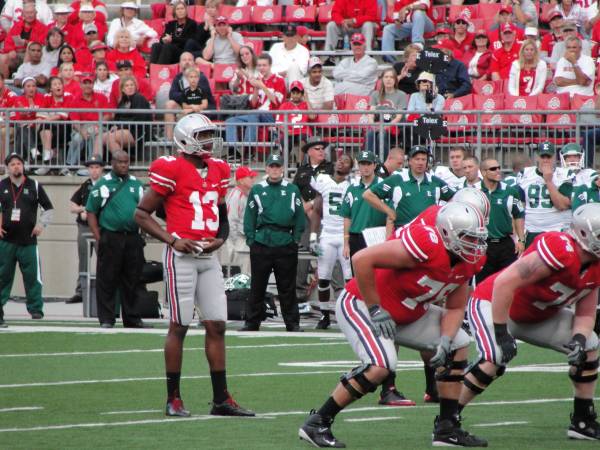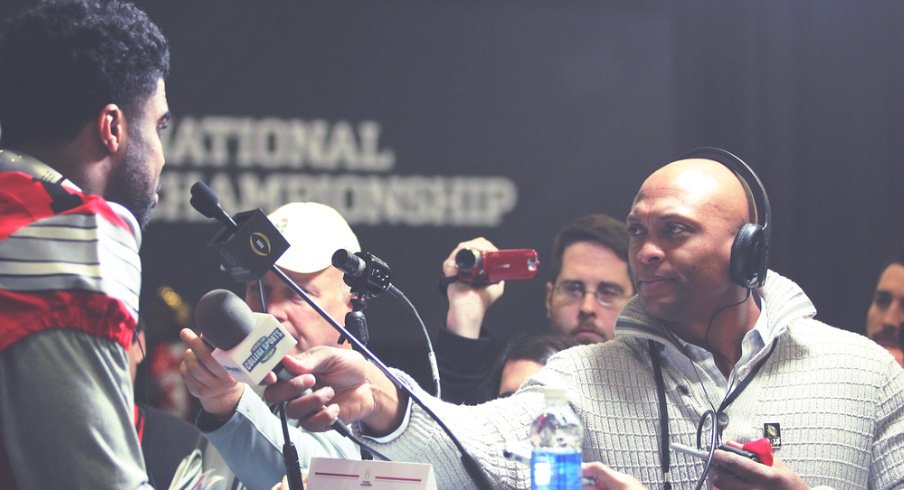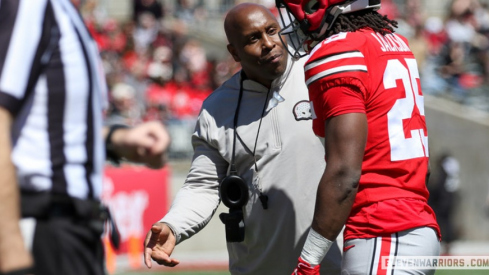Right now, in college football, the greatest sin is a lack of communication.
Which is wild. Absolutely, unbelievably, goofy-ass Looney Tunes stuff.
Because for over a decade now, yours truly has watched the Sisyphean burden taken on by sports media in an effort to wring out the tiniest drop of blood from the stone that is athletic departments, coaches, and players. Ohio State representatives at all levels have, for years, been coached not just in football, but also in how to handle the media; how to deflect incoming questions like Bruce Lee in Enter the Dragon and bob and weave their way around controversial topics also like Bruce Lee in Enter the Dragon.

In normal times, college football programs wear their evasiveness like a badge of honor.
I saw this firsthand when I was the Eleven Warriors media representative for Ohio State's beatdown of Eastern Michigan in 2010. Though the Buckeyes won that game 73-20 (Kenny Guiton even scored a touchdown, which was kickass), defensive coordinator Jim Heacock took it upon himself to explain to the media after the game how EMU could muster 20 points against the Buckeyes in Ohio Stadium.
And the thing of it was, pretty much everyone in that room could've told you exactly what he was going to say before he said it. Short, direct, canned answers to things almost everyone already knew.
This applies to positive things, too! Even when Dwayne Haskins was destroying every quarterbacking record in the Big Ten universe, asking Urban Meyer about it was like getting blood from an incredibly predictable stone.
So the norm in college football is to not make waves, to keep answers short, direct, and close to the vest, and never reveal more about the inner turmoil of a team than is absolutely necessary.
That's all been thrown out the window.
It is staggering to see how every possible avenue for communication has been used by people in and around the Ohio State football team in recent weeks.
The full might of the Buckeye collective has been utilized in an effort to see football happen sooner rather than later.
Justin Fields' petition is kind of remarkable in of itself; a college football superstar leveraging his popularity to directly confront conference leadership using a social media platform. Almost 300,000 people signing on to his letter might make some heads turn, but I'm equally impressed and fascinated that so many of his fellow teammates and coaches hopped on board as well.
The parent letters, which by now have been sent and seen by everyone in the college football world, are also unprecedented, as is their united and sustained outreach to the media. To have this kind of organization, and even protest, is something that would be unheard of in this fashion before COVID-19.
Finally, the weight of Ohio State's media machine has been used in a way I never expected:
(Imagine, as a Buckeye football fan, watching this video two years ago.)
The most essential part of the petitions, and parent letters, and protests surrounding the decision to cancel football this fall is that this kind of engagement puts the onus on the leadership of the Big Ten to effectively communicate their intentions and reasons for doing so. And they need to do it just as skillfully and forcefully as the people who disagree with the decisions they've made are making their voices heard.
If Kevin Warren and company can't handle this moment of communication skillfully (and, again, he has absolutely failed to do that so far), it won't matter if they're right; that yes, shutting down fall sports was ultimately the smart and safe thing to do for the community. All that will come through to many is the idea that the leadership of the Big Ten hates sports, or wants you to be miserable, or has some political agenda, or whatever other ridiculous conspiratorial crap that tends to emerge in the absence of a coherent message from decision makers.
Which is the real danger here. It is more than appropriate that the voices of parents and players are heard, and loudly. They are important stakeholders in the outcome of whatever happens with college football. The risk is instead that the seriousness of the larger issue, a pandemic that has killed over 170,000 people in the United States alone, will be diminished because one side of the conversation surrounding college football has essentially abdicated its role in making an argument.
If that happens, what'll replace it is, well... nothing. The imaginations of trolls and douchebags will run wild to fill the vacuum created by the absence of substance. And not only that, but athlete voices that dissent from the overall narrative will be drowned out and ignored.
So Warren's open letter from a few days ago is just the start of a necessary engagement that the Big Ten conference has been far too slow to put into place. It's true that anything he says or does will be nitpicked and (at times unfairly) critiqued, but outreach is a critical part of his job. There may be more in the coming days, and for his sake, I would hope so.
Ultimately, this is a fascinating, incredible snapshot of a college athletics world that is completely unrecognizable to the one that existed just a few years ago. A serious crisis on so many levels has forever changed how we view this landscape, and as 2020 rolls on and gives way to 2021, I'm certain that it will continue to change further.
How we tell that story to ourselves and how we try and convince others that our version of events is the correct one will say a lot about the actions we ultimately take.


